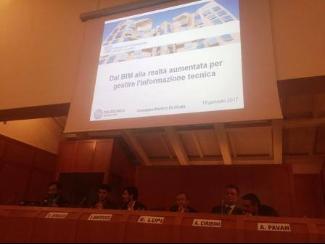 05
Dicembre
2017
05
Dicembre
2017
BIM: ceramic products become smart
The enormous potential of Building Information Modelling and construction digitisation in general, with a focus on the opportunities available to ceramic companies and architects
The event held on 18 January 2017 was organised by Federazione Confindustria Ceramica e Laterizi with the aim of illustrating the enormous potential offered by Building Information Modelling and digitisation of the construction process in general, with a particular focus on the opportunities available both to ceramic sector companies and to architects.
Enrico Lupi from the Economics Department of Confindustria Ceramica moderated the conference and introduced the speakers, noting that BIM reflects the enormous potential offered by the process of digitisation in the building and ceramic sectors. “Both the brick and the ceramic tile industries already have significant experience with BIM,” he said. “Around 80% of Italian ceramic tiles are exported to markets where this approach is already widely adopted.”
First to speak was Professor Angelo Ciribini from the University of Brescia, who discussed the international regulatory framework and focused in particular the theme of digitisation. “At an international level, Europe is devoting the maximum attention to digitisation,” he said. “This is demonstrated by the work of the CEN Technical Committee 442 devoted to BIM, which is divided into five working groups (Strategy and Planning; Exchange Information; Information Delivery Specification; Support Data Dictionaries; Chairperson’s Advisory Group), led by the UK and France with the aim of modernising the organisational structure of the international market. There are clearly policies and guidelines in place aimed at achieving systems intelligence. The problem is the structure of the market and identification of new drivers.”
Professor Alberto Pavan from Milan Polytechnic noted that we no longer have a choice with regard to the digital market. BIM is a method for simulating the construction process that makes it simple to use information that has been collected on materials. “If we think about the possible implications of the way this technology is currently used, we can imagine that a digital graphic object will become essential for the safety of buildings (for example, when a material reaches the end of its lifetime an automatic alert could be sent to replace it).”
Turning to regulatory aspects, he quoted the Italian Procurement Code and discussed Italian standard UNI 11337 (Digital management of information processes in construction – BIM), noting that it is no coincidence that unlike the previous standard of 2009 it defines time and quality management of the process. “There is an urgent need today to define flows as a necessary and sufficient condition for interconnected information to be deliverable.”
Professor Giuseppe Di Giuda from Milan Polytechnic endorsed his co-speakers’ comments and discussed the theme of Augmented Reality as a valid tool for supporting the design and management of a work. “One of the biggest complaints in the construction sector,” he said, “is that every time a building is constructed, it is its own prototype. There are no test benches for making mistakes and alterations, for replicating and confirming the choices we have made. All other sectors enjoy the advantage of having a pilot” […] “With Augmented Reality, anyone can identify with the action they are viewing.”
The last presentation in the conference was given by architects Vito Sirago and Vincenzo Montefusco from ARUP Italia, who discussed the possible implications of so-called Computational Design, of which BIM is a component. “From the designer’s perspective, BIM is the solution for achieving the three essential goals of design: saving time; optimising solutions; creating alternative designs.”
Sirago and Montefusco illustrated their arguments with concrete examples of the effects of using BIM as a key technology for large works such as the Libeskind Tower in the City Life district of Milan and the Dr Chau Chak Wing Building in Sydney.
Well aware of the enormous value of digital applications in state-of-the-art construction, the Federazione Confindustria Ceramica e Laterizi concluded this interesting event with a pledge to maintain a stronger presence in the European regulatory meetings on BIM. It also undertook to forge close partnerships with universities and specialist architects with the aim of using the most effective BIM technologies currently available to support sector companies.
The complete video of the conference can be viewed at the following link: